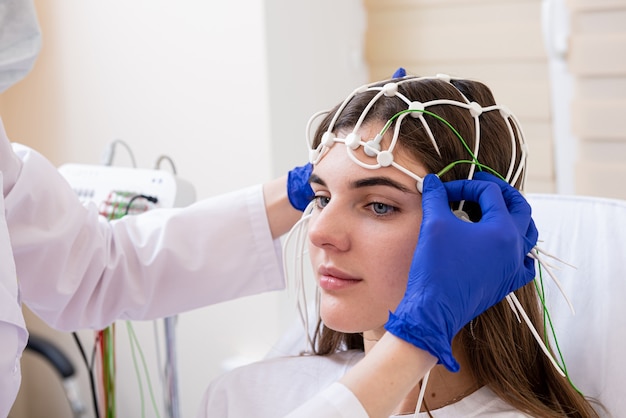At-Home EEG
Create a requestAt-Home EEG (Electroencephalogram) is a non-invasive method to record electrical activity of the brain. By using electrodes attached to the scalp, this procedure captures patterns that can provide crucial information about brain function and detect abnormalities.

General
At-Home EEGs offer the convenience of conducting a neurological assessment in the comfort of the patient's own home. This technique uses a portable EEG device equipped with electrodes that are placed on specific locations on the scalp. Once activated, the device records the brain's electrical activities, often over a period of 24 to 48 hours, to capture a comprehensive view of brain function during various states such as sleep and wakefulness. The collected data is then analyzed by professionals to detect any irregularities that could indicate neurological disorders. This approach has become increasingly popular due to its accessibility and the comfort it provides to patients, especially those with mobility issues or who experience significant stress in clinical environments. It's crucial for diagnosing conditions like epilepsy, sleep disorders, and to assess brain activities after a head injury. It also allows continuous monitoring over extended periods, which can be essential for capturing infrequent yet critical events that might not be detected during a traditional in-clinic EEG session.
Special Details
Who is it for?
- Individuals experiencing symptoms such as seizures, unexplained periods of loss of consciousness, or other neurological symptoms.
- Patients needing long-term monitoring for diagnosis of conditions like epilepsy, sleep disorders, or irregular brain activities.
- Patients who cannot easily travel to a hospital or clinic due to mobility issues or severe health conditions.
- Children or adults who may experience stress or anxiety in a clinical setting, making in-home testing a preferred option.
Recovery Period
- The at-home EEG procedure itself is non-invasive and does not require a recovery period.
- The duration of the procedure typically ranges from 24 to 48 hours of continuous monitoring.
- After the electrodes are removed, patients can resume their normal activities immediately.
Potential Risks and Side Effects
- Skin irritation or mild rash where the electrodes were attached.
- Allergic reaction to the adhesive used in the electrodes.
- Discomfort or inconvenience due to wearing the device for an extended period.
Alternative Treatments
- In-clinic EEG for more immediate or severe cases requiring direct supervision by healthcare professionals.
- Ambulatory EEG that also allows for movement but typically within a healthcare facility.
- MRI or CT scans for structural brain imaging, though these do not capture brain electrical activity.
Success Rate
The success rate of at-home EEG largely depends on the purpose of the study, but it generally has high accuracy for detecting abnormalities in brain activities. However, it's crucial for the equipment to be correctly set up and for patients to follow usage instructions carefully for precise results.
Procedure step-by-step overivew
- A trained technician explains the procedure and prepares the patient’s scalp.
- Electrodes are then attached to the scalp using a special gel or adhesive.
- The electrodes are connected to a portable recording device, which the patient will carry with them.
- The patient is instructed on how to maintain the equipment and what activities to avoid.
- Recording begins, capturing the brain’s electrical activity over the prescribed duration.
- After the monitoring period, the patient returns the device following the provided instructions.
- Data from the device is analyzed by a neurologist or a specialized technician to diagnose or rule out conditions.
Prices
Why Do Prices Vary?
- The type of EEG device used and the length of the monitoring period.
- Professional fees for data analysis and report preparation.
- Specific needs of the patient, such as additional monitors for other conditions.
- Shipping or service charges for delivering and returning the device.
- Turkey
- $200-$500
- Czech Republic
- $250-$550
- Croatia
- $250-$550
- Lithuania
- $300-$600
- Poland
- $300-$600
- Germany
- $350-$700
- Switzerland
- $400-$800
- France
- $350-$700
- United Kingdom
- $400-$800
- United States
- $400-$1000
- Canada
- $350-$900
- Australia
- $350-$800